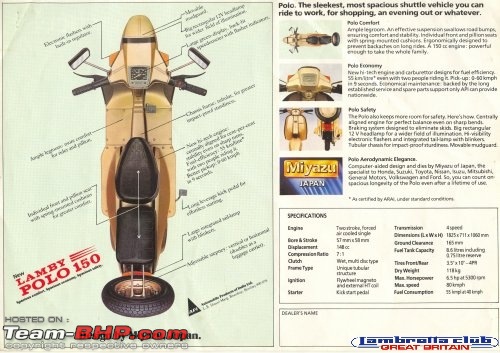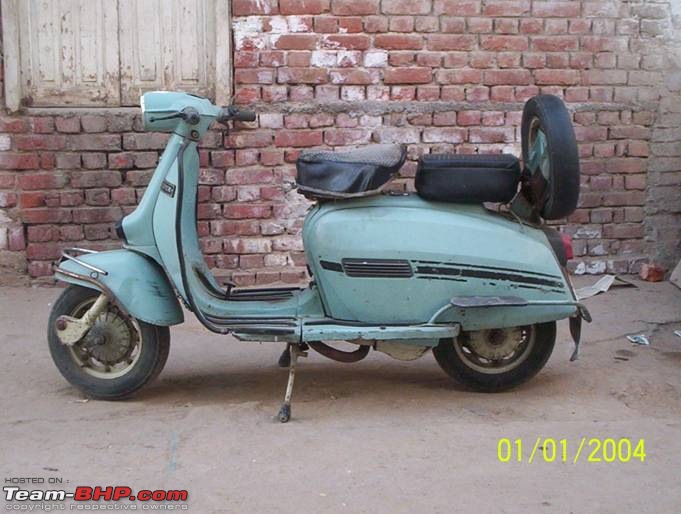Yezdi enthusiast Javed Nayeem wrote the following on :
Yezdi « churumuri K. JAVEED NAYEEM writes: I may not be wrong if I say that without any exceptions whatsoever, a motorcycle is every boy’s favourite fascination and heart-throb.
It still remains mine too since, at heart, I still feel like a boy although my wife dissuades me from owning one on the plea that it is rather unsafe to ride one today considering the dangerous traffic conditions. I often wonder if that is the real reason for her fears, considering the fact that bikes still rank very high among the list of things that make boys attractive to girls!
Among the many credits that our City can take, it also stands out as the hometown of Jawa and Yezdi, two among India’s best-known motorcycles of the yesteryear. Along with the 175cc Rajdoot, and the Royal Enfield breed, these were the only motorcycles that were produced in the country until the modern-day 100cc bikes came along in the late eighties, like a bolt from the blue, to overtake them.
The Jawa workhorse came to India thanks to the vision and the enterprise of
F. K. Irani who started assembling them in an industrial shed in Yadavagiri under collaboration with the parent company located in Prague in Czechoslovakia.
The firm was called M/s Ideal Jawa Pvt. Ltd. and it stood not too far from the now demolished sprawling Jawa factory.
Originally it was the partnership of
Janeck, an arms manufacturer and
Wanderer, who true to his name, was keen on manufacturing motorcycles which first gave birth to a bike that derived its name from the first two letters of their own names! The year was 1929 when the going was good and fuel cheap and therefore the first bikes that rolled out of the factory had massive 500cc 18BHP engines.
The company even produced a 700cc Jawa car for a short while but when the world went into the economic recession of the terrible thirties, the engines were scaled down to 175cc in the year 1932 and under the rigours of World War II, which left no one unaffected, production was altogether stopped temporarily in the year 1946.
The factory was restarted after it was taken over by the Germans and later by the Soviets who merged the Jawa trademark with CZ, which was another Eastern European motorcycle brand. The 1935 model 250cc Kyrvaka was the forerunner of the Indian model while the 1954 version known as the type 353, was what first came to India in a knocked down state to be assembled and later fully manufactured here.
The first bike rolled out of the Mysore plant on 5th March, 1961 and once production started in full swing, there was no looking back over the next thirty-five years. Most of its variants were a phenomenal success mainly because of their extremely simple and yet rugged design that literally made them workhorses sans cumbersome maintenance.
Between 1963 and 1966, the bikes dominated the six-day international off-road Enduro trials where both bikes and riders are left to fend for themselves for six days at a stretch. The first phase of the collaboration with the parent company ended in the year 1968 and in the year 1975 the brand name of the bike was changed to Yezdi.
That year F. K. Irani was the Chairperson of the Mysore Dasara Committee and that year’s Dasara thus saw forty Yezdi motorcycles participating in the procession. It was also the year when Roadking, which true to its name became the most successful model, was unveiled. It still remains the most sought after and valued Yezdi with collectors.
Initially, it was available only against the payment of 150 US Dollars in foreign exchange and therefore became a status symbol and a very prestigious possession. Manufactured to last a lifetime, many Jawa and Yezdi bikes regularly outlived their owners, a few of whom performed outlandish stunts like riding them standing on their saddles or across winding hill roads with hands completely off the handlebars.
Some riders even rode them up the steps of the Vidhana Soudha and the Chamundi Hill! Their reliability saw them exported to Afghanistan, Turkey, Egypt and Sri Lanka and also to Nigeria where they were inducted for use by the Police force. This explains why Jawa was the most sought after bike by the many Nigerian students who used to come to India for studies.
Over the years, Jawa engines have successfully powered mini-tractors, railway track inspection trolleys, autorickshaws, sugarcane crushers and thanks to the ingenuity of our home-grown aviator, Somender Singh, even micro-light aircraft!
Despite such a glorious track record, this phenomenal performer that was to motorcycling what the AK-47 still is to small arms across the world, saw the end of its production in the year 1997 when the technology behind it could not keep pace with what came out of modern day Japan, initially in the minuscule 100cc package. The company shut shop and we all know what happened thereafter.
While a few diehard Jawa and Yezdi bikes still not only survive but also continue to serve their loving masters, this rather sad story thankfully has a happy ending.
Close to my house but unknown to me for a long time, there lives a family that has been keeping the Jawa heart beating softly in the warmth of their home.
Gladstone Wilson, who served as a supervisor at the Jawa factory since 1969 till its closure and his two sons,
Gavin and
Ainsley, have been passionately collecting and restoring the out-of-production Jawas and Yezdis over the years. Most of their bikes not only are road-worthy but also maintained in mint condition.
They have with them all the models that rolled out of the Mysore factory from the 60cc “Jet” to the last produced 250cc “Monarch”. They also have a very rare twin-cylinder 350cc version, which Gavins says is like Caesar….., more powerful dead, than alive because of its value and popularity now rather than when it was in production!
Gavin who heads the Department of English at the University Evening College says that his father has ridden a Jawa all along and his mother
Marie Wilson who teaches at the Ideal Jawa Rotary School too was using a Jawa stepthru 60cc “Colt” until very recently. He adds that his younger brother Ainsley who now works for Satyam Computers was almost born on a Jawa as his mother was rushed to the labour ward on the bike just in time for the event!
Over the past few years, the Wilson brothers along with their first cousin
Ryan who works for the Royal Inn Hotel, have formed a small group of Jawa and Yezdi owners in Mysore. They along with other Jawa fans the world over, celebrate the “CZ-Jawa-Yezdi International Day” on the second Sunday of July every year, when they ride their steel and chrome steeds across the main streets of the city, of course, with a brief stop to pay silent homage, at the factory site in Yadavagiri.
Although the Wilsons have been my immediate neighbours, I never knew about their unusual passion until my son
Adnan told me that there was a good story for my column locked up in the garage next-door. Gavin’s six- year-old son
Jaden, who lives and breathes motorcycles, is perhaps the youngest Jawa aficionado in the world, which may qualify him for an entry into the record books!
The Wilsons say that their greatest source of strength in sustaining their hobby is their chief mechanic
Mohamed Dastagir and his son
Shamsheer who have their workshop behind the Dalvoy School. They are also very grateful to all their friends and especially to
Raian Irani, son of F. K. Irani, who flagged off their first rally and
Rajashekar who sponsored their “Jawa Day” this year with a lunch at his farmhouse.
Although they say that the event can do with a little more help and publicity, they are reluctant to accept sponsorship that may dilute the Jawa name and logo with its own brand. It may be noted that Jawa and Yezdi owners in Pune have a full-fledged club with official membership.
Another noteworthy bike worth mentioning here is a 1962 model 175cc Jawa, bearing registration number MYB 8338 which was owned for exactly four decades by
M. M. Prasanna Kumar, my former science teacher at the St. Philomena’s High School. It was the 300th motorcycle produced by Ideal Jawa at Mysore, which was presented as a commemorative gift by the factory to
B. D. Jatti when he was the Governor of erstwhile Mysore State.
After two ownership changes, it came into the able hands of Prasanna Kumar who is himself a very accomplished two-wheeler and radio mechanic who can repair or restore anything mechanical or electronic. After a long and useful life, this bike was gifted in perfect running condition, along with its original registration certificate book, to the museum of the
Sri Manjunatheshwara Temple at Dharmasthala last Saturday.
Incidentally, it is the only Jawa motorcycle there and I feel it will now enjoy not only its rightful place of honour among the other interesting exhibits but its well-earned rest too, living up to its sobriquet; “Forever Bike, Forever Value.”
(
K. Javeed Nayeem, MD, is a practising physician who writes a weekly column for Star of Mysore, where this piece originally appeared
 (3)
Thanks
(3)
Thanks














